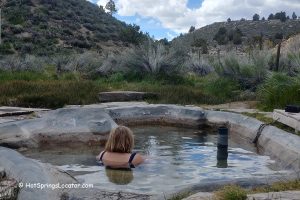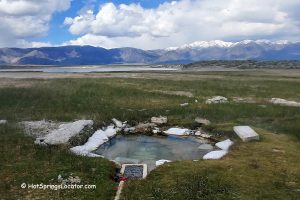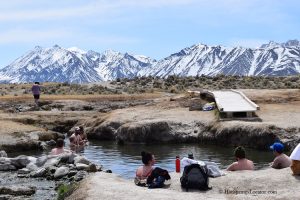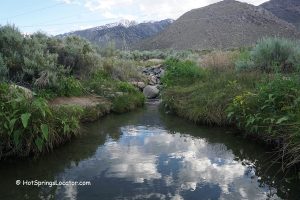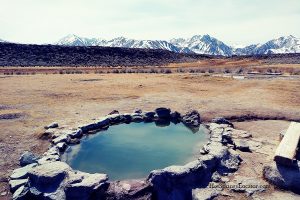
• Hot Creek Geological Site is known for its boiling geysers, turquoise-colored pools, and fumaroles
• Hot Creek has been closed to all bathing activities since May 2006
Known for its boiling geysers, turquoise-colored pools, and fumaroles, the Hot Creek Geologic Site is a unique geothermal area where you can observe impressive volcanic geology in action.
The Site is located in a small canyon of Hot Creek that flows through the Long Valley Caldera in the Inyo National Forest.
Overview of Hot Creek Geothermal Area
The Hot Greek Geothermal Area is where two kinds of water meet and merge, creating a fascinating, sometimes violent, landscape. Even though both kinds are overall your good old H2O, each arrives at the Geologic Site in a completely different fashion.
The first kind of water is the water from the melted snow of the Sierra Nevada that filters down through the cracks in the Earth's crust. Then it gets heated to 430°F (220°C) by the molten magma beneath the Inyo Crater and Domes.
Pressurized hot water travels about 10 miles eastward before emerging along the Long Valley Caldera, a 10 by 18-mile depression created by massive volcanic explosions over 700,000 years ago. The caldera is an exceptionally geologically active place experiencing small but frequent earthquakes. Due to ongoing geological changes, new hot springs can appear at Hot Creek anytime.

The second kind of water is Hot Creek itself, which starts as cool-water Mammoth Creek originating as an outflow from Twin Lakes and is fed by snowmelt. The stream becomes Hot Creek as it enters the Hot Creek Gorge. It then reaches the geothermal area and mixes with much hotter water from underground thermal vents. The hot water flows into the creek at the rate of about 240 liters per second, dramatically elevating the creek's temperature.
At Hot Creek Geologic Site, the water temperature reaches 199°F (93°C). At an elevation of 7,000 feet, this is almost boiling hot.
The temperature gradually drops as the water continues further east and mixes with cooler sources. At Crab Cooker Hot Springs, the water cools to around 150°F (65°C). Further out, at Crowley Hot Springs - also known as Wild Willy's - roughly five miles east of Hot Creek, the temperature drops below 110°F (43°C).

Hot Creek was once a popular destination for swimming and soaking. All bathing activities have been prohibited since May 2006 due to the area's dangerous and unpredictable geothermal activity.
Boiling water can erupt from the stream's bed or along its banks without warning as flow rates, temperatures, and geyser activity can shift in a matter of seconds. These sudden discharges of scalding, pressurized water make the area extremely hazardous. As a result, many of the places once popular with swimmers are now roped off for safety.
Since 1998, at least 14 people have died or suffered severe burns at Hot Creek, and many others have received other injuries. Entering the water at the Site is strictly prohibited. Visitors are strongly advised to stay on designated paths and refrain from crossing into fenced or restricted areas.
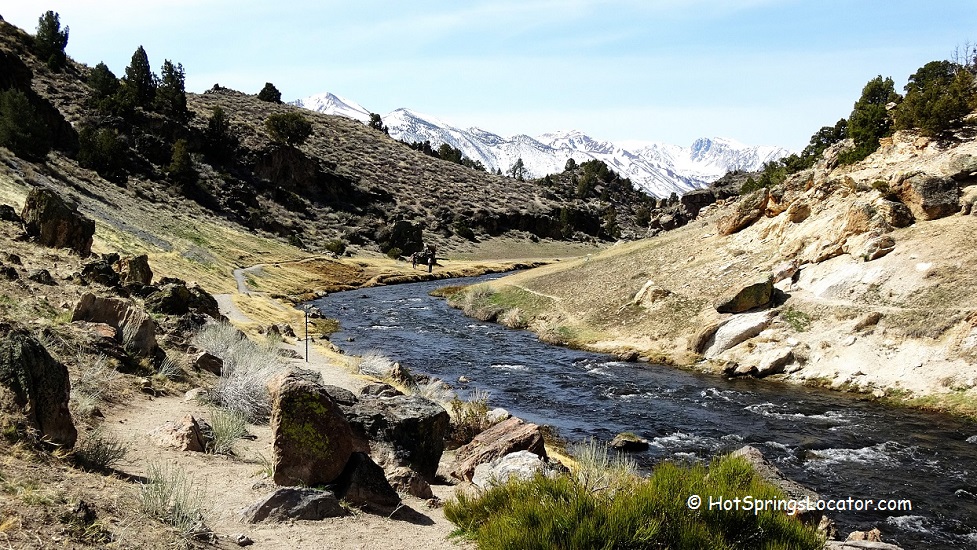
While soaking is no longer permitted at Hot Creek, several primitive hot springs in the Long Valley Caldera remain available. Nearby options include Shepherd Hot Springs, Crab Cooker Hot Springs, Hilltop Hot Springs (also known as Pulky’s Pool), Rock Tub Hot Springs, and Crowley Hot Springs (Wild Willy’s).
Hot Creek is also a popular destination for wild trout fishing, with catch-and-release regulations in place to preserve the fish population.

Visiting Hot Creek Geothermal Area
Visitors can explore the Hot Creek Geologic Site daily from sunrise to sunset. During winter, snow lovers can access the area via cross-country skiing, snowmobile, or snowshoeing -each method offering a scenic and adventurous way to enjoy the sight of the brilliantly blue pools and the surrounding geothermal landscape. With sweeping views of the Eastern Sierra, Hot Creek Geologic Site is a favorite among outdoor enthusiasts and photographers alike.
Caution is essential when visiting. The Hot Creek Geothermal Area is extremely hazardous due to scalding water, steam vents, sudden temperature changes, fragile ground, and the presence of arsenic in the water. Eruptions can occur without warning. Always keep children at a safe distance and ensure dogs are always leashed.
Video
Hot Creek Geological Site Camping & Lodging
Camping is not permitted at the hot springs. You can camp on public land or at Brown's Owens River Campground, which is located five miles away.
The closest accommodations are available in Mammoth Lakes, 12 miles west.
Affordable vacation rentals for short and long term stay at Mammoth Lakes
Hot Creek Geological Site | Facts
Dangerously Hot for Soaking
Location: 10 miles east of Mammoth Lakes • California • USA
Open: Year-round
Amenities: Interpretive site, vault toilet
Hiking distance: Short
Road Access: Any vehicle
Day-use fees: None
Restrictions: No camping, no swimming, no fishing, dogs must be on leash, no climbing into the fenced off areas
Managed by: U.S. Forest Service
Elevation: 7,000 ft (2,130 m)
Water T° (source): 199°F (93°C)
More Adventures
Directions to Hot Creek Geological Site
From Mammoth Lakes,
- Travel 3.1 miles southeast on CA-203 E (Main Street) to US-395
- Merge right onto US-395 and drive 3.1 miles southeast to Hot Creek Hatchery Road
- Turn left onto Hot Creek Hatchery Road and continue 3.4 miles. Bear slightly left on the fork at Hot Creek Ranch (halfway). The destination will be on the left.
From Benton Crossing Road,
- Turn northwest onto Whitmore Tubs Road and drive 2.7 miles to Hot Creek Hatchery Road
- Turn left onto Hot Creek Hatchery Road and continue 1 mile to the destination on your right.

